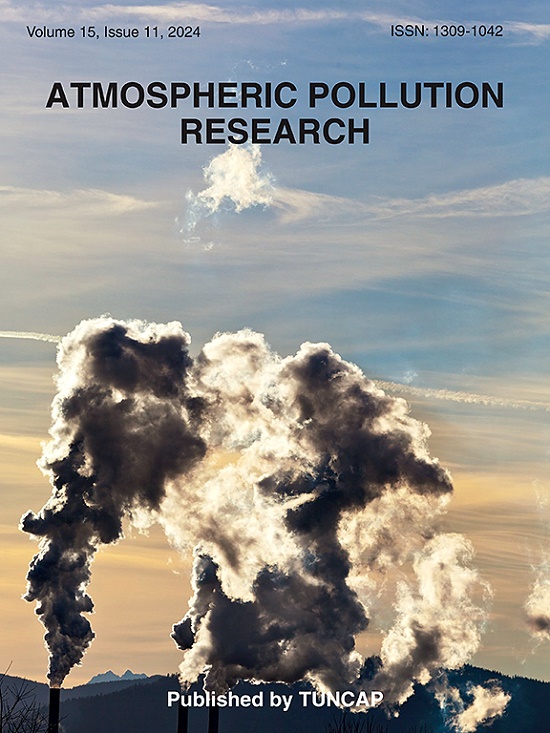有用的每小时测量甲醛在PAMS站点在纽约
IF 3.5
3区 环境科学与生态学
Q2 ENVIRONMENTAL SCIENCES
引用次数: 0
摘要
在2-3年的时间里,在纽约的两个地点(纽约植物园(NYBG)和亚麻池)使用Picarro空腔衰荡光谱仪器(型号为G2307)进行了每小时的HCHO测量。HCHO数据通过每小时采样10分钟的零空气来校正基线漂移。然后将零校正后的HCHO数据与2,4-二硝基苯肼(DNPH)药筒样品的HCHO数据进行比较。按季度平均的差异被用来调整皮卡罗工具偏差。校正后的Picarro数据与Aerodyne可调谐红外激光直接吸收光谱(TILDAS)仪器的测量结果一致。HCHO在夏季表现出明显的日珥模式,峰值浓度为3.4-3.9 ppbv,大约在中午到下午早些时候,最低浓度为1.4-1.9 ppbv,大约在凌晨4-5点。夏季平均浓度比冬季高2-3倍,具有很强的季节梯度,表明二次生产的重要性。社区多尺度空气质量模式模拟的HCHO浓度低于NYBG观测值,表明城市地区HCHO和生物源异戊二烯的排放可能过低。除4月和5月模型值较低外,亚麻塘模拟的HCHO值总体上更接近观测浓度。Picarro G2307具有在亚ppbv范围内提供准确的高时间分辨率HCHO数据的潜力,这对于模型评估是有用的,只要它校正了基线漂移和仪器偏差。本文章由计算机程序翻译,如有差异,请以英文原文为准。
Useful hourly measurements of formaldehyde at PAMS sites in New York
Hourly measurements of HCHO were carried out over a period of 2–3 years, at two New York sites (New York Botanical Gardens (NYBG) and Flax Pond) using Picarro cavity ring-down spectroscopy instruments, model G2307. HCHO data was corrected for the baseline drift by sampling zero air for 10 min on an hourly basis. The zero corrected HCHO data were then compared to collocated HCHO data from 2,4-dinitrophenylhydrazine (DNPH) cartridge samples. The difference averaged on a quarterly basis was used to adjust for the Picarro instrumental bias. The corrected Picarro data were found to agree well with collocated measurements from an Aerodyne Tunable Infrared Laser Direct Absorption Spectroscopy (TILDAS) instrument. HCHO showed a pronounced diel pattern in summer, with peak concentrations of 3.4–3.9 parts per billion by volume (ppbv), around noon to early afternoon, and a minimum of 1.4–1.9 ppbv, around 4–5 a.m. A strong seasonal gradient was observed with mean summer concentrations a factor of 2–3 higher than in winter, indicating the importance of secondary production. HCHO concentrations simulated by the Community Multiscale Air Quality model were lower than observed at NYBG, indicating that the emissions of HCHO and biogenic isoprene may be too low in urban areas. At Flax Pond modeled HCHO values were generally closer to observed concentrations except for April and May when modeled values were lower. The Picarro G2307 has the potential to provide accurate high temporal resolution HCHO data in the sub ppbv range, which is useful for model evaluation provided it is corrected for baseline drift and instrumental bias.
求助全文
通过发布文献求助,成功后即可免费获取论文全文。
去求助
来源期刊

Atmospheric Pollution Research
ENVIRONMENTAL SCIENCES-
CiteScore
8.30
自引率
6.70%
发文量
256
审稿时长
36 days
期刊介绍:
Atmospheric Pollution Research (APR) is an international journal designed for the publication of articles on air pollution. Papers should present novel experimental results, theory and modeling of air pollution on local, regional, or global scales. Areas covered are research on inorganic, organic, and persistent organic air pollutants, air quality monitoring, air quality management, atmospheric dispersion and transport, air-surface (soil, water, and vegetation) exchange of pollutants, dry and wet deposition, indoor air quality, exposure assessment, health effects, satellite measurements, natural emissions, atmospheric chemistry, greenhouse gases, and effects on climate change.
 求助内容:
求助内容: 应助结果提醒方式:
应助结果提醒方式:


